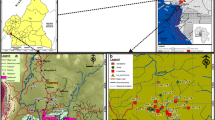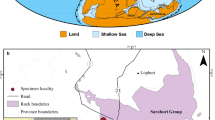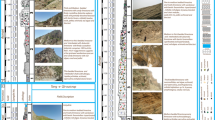Abstract
Carbonate reef talus facies of the Koněprusy Limestone (Pragian, Lower Devonian, Barrandian) locally exhibit widespread impregnation by organic matter resulting in a partial to complete blackening of the limestones. Two contrasting types of impregnation are recognized: blackening of individual carbonate fossils and bioclastic layers within the limestone originated very early during diagenesis. The blackening is due to finely dispersed organic matter and possibly some iron sulphides and clay minerals that selectively adhered to the outer layers of corals, bryozoans, and crinoid fragments, leaving other fossils unaltered. These darkened fossils are similar to black pebbles—i.e., reworked, dark to black limestone clasts and bioclasts that are known to occur exclusively in shallow-water zones of both ancient and modern carbonates. The alteration of fossil fragments may have taken place in very shallow-water environments, possibly those of saline and reducing back-reef lagoons or supratidal-intertidal zones, with organic matter being derived from decayed algae and microbes, or early vascular terrestrial plant material. Following the coloration, the blackened fossils were removed from their original position by waves or storms and transported into relatively deeper-water reef slope settings to form graded, “salt-and-pepper”-colored bioclastic beds. The presence of blackened fossils in the carbonate succession may point to episodic emergence and indicates a vanished vegetated siliciclastic hinterland that may once have existed to the west or south from the present-day erosive edge of the Barrandian Devonian strata. Subvertical veins cutting the Koněprusy Limestone and filled with black solid bitumen and blackened calcite resulted from a subsequent but substantially later diagenetic event, which is a testament of aqueous and petroleum fluid migration through the succession during deeper burial. Microthermometric characteristics of the aqueous inclusions embedded in vein calcite indicate that the veins were precipitated by brines of low to moderate salinity (0.5–9.5 wt% NaCl equiv.) with temperatures in the range of 87–116°C. The bitumen in the veins is epi-impsonite (Rr = 0.70–1.90%), which is interpreted as degraded petroleum residuum that experienced thermal alteration at around 120°C. The AFT modeling combined with fluid inclusion microthermometry and wider geological considerations indicate that the veins originated during the Variscan orogeny, most probably upon deep burial of the Lower Paleozoic strata in Carboniferous time.
















Similar content being viewed by others
References
Barker CE, Goldstein RH (1990) Fluid inclusion technique for determining maximum temperature and its comparison to the vitrinite geothermometer. Geology 18:1003–1006
Belka Z, Narkiewicz M (2008) Devonian. In: McCann T (ed) The geology of central Europe. Vol. 1: Precambrian and Palaeozoic. Geol Soc Lond, pp 383–410
Beyssac O, Goffé B, Chopin C, Rouzaud JN (2002a) Raman spectra of Carbonaceous material in metasediments: a new geothermometer. J Metamorph Geol 20:859–871
Beyssac O, Rouzaud JN, Goffé B, Brunet F, Chopin C (2002b) Graphitization in a high-pressure, low-temperature gradient: a Raman microspectroscopy and HRTM study. Contrib Mineral Petrol 143:19–31
Bodnar RJ (1990) Petroleum migration in the Miocene Monterey Formation, California, USA: constraints from fluid-inclusion studies. Mineral Mag 54:295–304
Bodnar RJ, Vityk MO (1995) Interpretation of microthermometric data for H20-NaCl fluid inclusions. In: De Vivo B, Frezzotti ML (eds) Fluid inclusions in minerals: methods and applications. Short course of the Working Group “Inclusions in Minerals”. Virginia Polytechnic Institute, Blacksburg, pp 117–130
Bodnar RJ, Reynolds TJ, Kuehn CA (1985) Fluid-inclusion systematics in epithermal systems. In: Berger BR, Bethke PM (eds) Geology and geochemistry of epithermal systems. Society of Economic Geologists, Review in Economic Geology 2:73–97
Borisenko AS (1977) The study on salt composition of fluid inclusions in minerals by cryometric method. Geolog Geofiz 8:16–28 (in Russian)
Brandon MT (1992) Decomposition of fission-track grain-age distribution. Am J Sci 292:535–564
Burchette TP (1981) European Devonian reefs: a review of current concepts and models. In: Tommey DF (ed) European fossil reef models. Soc Econ Paleontol Mineral Spec Publ 30, Tulsa, pp 85–142
Burrus RC, Cercone KR, Harris PM (1985) Timing of hydrocarbon migration: evidence from fluid inclusions in calcite cements, tectonics and burial history. In: Schneidermann N, Harris PM (eds) Carbonate cements, Soc Econ Paleontol Mineral Spec Publ 36, Tulsa, pp 277–289
Carlson WD, Donelick RA, Ketcham RA (1999) Variability of apatite fission track annealing kinetics: I. Experimental results. Am Mineral 84:1213–1223
Chlupáč I (1967) The Devonian of Czechoslovakia and its stratigraphic significance. In: McMillan NJ, Embry AF, Glass DJ (eds) Devonian of the world. Proceedings of the second international symposium of the Devonian system, Calgary, Canada, Volume I: regional syntheses, Can Soc Petrol Geol, Calgary, pp 481–497
Chlupáč I (1984) Devon Zlatého Koně [The Devonian of the Golden Horse Hill (Zlatý kůň)]. Český kras (Beroun) 9: 17–27 (in Czech)
Chlupáč I (1993) Geology of the Barrandian. A field trip guide. Senckenberg-Buch 69, Verlag Waldemar Kramer, Frankfurt am Main
Chlupáč I (1996) Neptunian dykes in the Koněprusy Devonian: geological and palaeontological observations. Věstn Česk Geol Úst 71:193–208
Chlupáč I (1998) K faciím a stratigrafii spodnodevonského útesového komplexu u Koněprus [Comments on facies and stratigraphy of the Lower Devonian Reef Complex at Koněprusy, Barrandian area, Czech Republic]. Věstn Česk Geol Úst 73:1–13 (in Czech)
Chlupáč I, Havlíček V, Kříž J, Kukal Z, Štorch P (1998) Palaeozoic of the Barrandian (Cambrian to Devonian). Czech Geol Surv, Prague
Chlupáč I, Brzobohatý R, Kovanda J, Stráník Z (2002) Geologická minulost České republiky [The Geological Past of the Czech Republic]. Academia, Prague (in Czech)
Dubanský A, Zamarský V, Dobal V (1990) Montání vosk z karbonátových hornin Barrandienu [Earth Wax from Carbonate Rocks of the Barrandian Area] Sb Vědec Pr Vys Školy Báňské, řada HG 1:209–233
Engel MH, Macko SA (1993) Organic geochemistry: principles and applications. Plenum Press, New York
Esteban M, Klappa CF (1983) Subaerial exposure environment. In: Scholle PA, Bebout DG, Moore CH (eds) Carbonate depositional environments, Am Assoc Petrol Geol Mem 33. Am Assoc Petrol Geol, Tulsa, pp 1–54
Filip J, Suchý V (2004) Thermal and tectonic history of the Barrandian Lower Paleozoic, Czech Republic: is there a fission-track evidence for Carboniferous-Permian overburden and pre-Westphalian alpinotype thrusting? (Critical comments on the paper by Ulrich A. Glasmacher, Ulrich Mann and Günter A. Wagner). Bull Geosci 79:107–112
Flügel E (2004) Microfacies of carbonate rocks. Springer, Berlin Heidelberg New York
Franců E, Mann U, Suchý V, Volk H (1998) Model of burial and thermal history of the Tobolka-1 borehole profile in the Prague basin. Acta Univ Carol Geol 42:248–249
Franců J, Franců E, Boháček Z, Hladil J, Bosák P (2001) Analýza organické hmoty z tmavě zbarvených vápenců Velkolomu Čertovy schody-západ (The analysis of organic matter from dark-colored limestones in the Velkolom Čertovy schody-západ Quarry). Český kras 27:30–33 (in Czech)
Fröhlich S (2004) Phosphatic black pebbles and nodules on a Devonian carbonate shelf (Anti-Atlas, Morocco). J Afr Earth Sci 38:243–254
Galbraith RF (1990) The radial plot: graphical assessment of spread ages. Nucl Tracks Radiat Meas 17:207–214
Glasmacher UA, Mann U, Wagner GA (2002) Thermotectonic evolution of the Barrandian, Czech Republic, as revealed by apatite fission-track analysis. Tectonophysics 359:381–402
Goldstein HG, Reynolds TJ (1994) Systematics of fluid inclusions in diagenetic minerals. Soc Sediment Geol Short Course 32:1–199
Green PF (1988) The relationship between track shortening and fission track age reduction in apatite: combined influences of inherent instability, annealing anisotropy, length bias and system calibration. Earth Planet Sci Lett 89:335–352
Halavínová M, Melichar R, Slobodník M (2008) Hydrothermal veins linked with the Variscan structure of the Prague Synform (Barrandien, Czech Republic): resolving fluid-wall rock interaction. Geol Q 52:309–320
Havlíček V (1981) Development of a linear sedimentary depression exemplified by the Prague Basin (Ordovician: middle Devonian; Barrandian area, Central Bohemia). Sb Geol Věd Geol 35:7–48
Hips K, Haas J, Vidó M, Barna Z, Jovanović D, Sudar MN, Siklósy Z (2011) Selective blackening of bioclasts via mixing-zone aragonite neomorphism in Late Triassic limestone, Zlatibor Mountains, Serbia. Sedimentology 58:854–877
Hladil J, Gabašová A (1993) Záchranný geologický výzkum koněpruského rifu v hodině dvanácté [Salvage geological investigation of Koněprusy reef in last minute]. Zpr geol výzk v r 1992:33–34 (in Czech)
Hladil J, Slavík L (1997) Facie a stratigrafie koněpruských vápenců (Koněprusy, Velkolom Čertovy schody, spodní devon, stupeň prag) [Facies and stratigraphy of the Koněprusy limestones, Koněprusy, Čertovy schody Quarry, lower Devonian, Pragian stage]. Česk kras 23:5–18 (in Czech)
Hunt JM (1996) Petroleum geochemistry and geology, 2nd edn. W.H. Freeman and Comp, New York
Illing LV (1954) Bahamian calcareous sand. Am Assoc Petrol Geol Bull 38:1–95
Jacob H (1989) Classification, structure, genesis and practical importance of natural solid oil bitumen (“migrabitumen”). Int J Coal Geol 11:65–79
Jahn J (1892) Zur Frage uber die Bildung des Erdols. Jb Geol Reichsanst 42:360–373
Jahn J (1901) O anthracidech v českém siluru [On the occurrence of anthracides in the Silurian of Bohemia]. Čas prům chem 11:8–13
Ketcham RS, Donelick RA, Carlson WD (1999) Variability of apatite fission-track annealing kinetics III: extrapolation to geological time scales. Am Mineral 84:1235–1255
Ketcham RA, Donelick RA, Donelick MB (2000) AFTSolve: a program for multi-kinetic modelling of apatite fission-track data. Geol Mater Res 2:1–32
Killops SD, Killops VJ (1993) An introduction to organic geochemistry. Longman Scientific & Technical, London
Kříbek B, Hrabal J, Landais P, Hladíková J (1994) The association of poorly ordered graphite, coke and bitumens in greenschist facies rocks of the Poniklá Group, Lugicum, Czech Republic: the results of graphitization of various types of carbonaceous matter. J Metamorph Geol 12:493–503
Krohe A (1998) Extending a thickened crustal bulge: toward a new geodynamic evolution model of the Paleozoic NW Bohemian Massif, German continental deep drilling site (SE Germany). Earth Sci Rev 44:95–146
Kukal Z (1964) Litologie barrandienských karbonátových souvrství [Lithology of carbonate sequences of the Barrandian area]. Sb Geol Věd Geol 6:123–165 (in Czech)
Kukal Z (1985) Vývoj sedimentů Českého masívu [The evolution of sedimentary rocks of the Bohemian Massif]. Academia, Prague (in Czech)
Kukal Z, Jäger O (1988) Siliciclastic signal of the Variscan orogenesis: the Devonian Srbsko formation of Central Bohemia. Věstn Ústř Úst Geol 63:65–80
Lahfid A, Beyssac O, Deville E, Negro F, Chopin C, Goffé B (2010) Evolution of the Raman spectrum of carbonaceous material in low-grade metasediments of the Glarus Alps (Switzerland). Terra Nova 22:354–360
Landis CR, Castaño JR (1995) Maturation and bulk chemical properties of a suite of solid hydrocarbons. Org Geochem 22:137–149
Lang RA, Tucci P (1997) A preliminary study of the causes of the blackening of pebbles in the Cenomanian “Brecia with black pebbles” of Camporosello (Lepini Mountains Italy). Geol Romana 33:89–97
Leinfelder R (1987) Formation and significance of black pebbles from the Ota limestone (Upper Jurassic, Portugal). Facies 17:159–170
Lespade P, Marchand A, Couzi M, Cruege F (1984) Caractérisation de matériaux carbonés par microspectroscopie Raman. Carbon 22:375–385
Libertín M, Labuťa R, Dašková J (2003) Nález nejstarších cévnatých rostlin v Českém masívu [The oldest vacular plants from the Bohemian Massif]. Zpr geol výzk v r 2002: 127 (in Czech)
Maiklem WR (1967) Black and brown speckled foraminiferal sand from the southern part of the Great Barrier Reef. J Sediment Res 37:1023–1030
Malkovský M (1979) The platform cover of the Bohemian Massif and its tectogenesis. Ústř Úst Geol, Prague (in Czech)
Malkovský M (1987) The Mesozoic and Tertiary basins of the Bohemian Massif and their evolution. Tectonophysics 137:31–42
Melichar R (2004) Tectonics of the Prague Synform: a hundred years of scientific discussion. Krystalinikum 30:167–187
Nemanich RJ, Solin SA (1979) First- and second-order Raman scattering from finite-size crystals of graphite. Phys Rev B 20:392–401
Obrhel J (1961) Die Flora der Srbsko-Schichten (Givet) des mittelböhmischen Devons. Věst Ústř Úst Geol 26:7–46
Obrhel J (1968) Die Silur- und Devonflora des Barrandiums. Paläont Abh Abt B Paläobotanik Bd II, H 4:635–704
Obrhel J (1976) Bau und chemismus der stromatolitischen strukturen aus dem unter-Devon von Koněprusy (ČSSR). Acta Univ Carol Geol 1: 69–83
Obrhel J (1984) Algae and stromatolites of the Koněprusy Limestone. Česk kras 9:39–50 (in Czech with English and German abstracts)
Poty B, Leroy J, Jachimowicz L (1976) Un nouvel appareil pour la mesure des temperatures sous le microscope: L′installation de microthermometrie Chaixmeca. Bull Soc Fr Minéral Cristallogr 99:182–186
Rahl JM, Anderson KM, Branon MT, Fassoulas C (2005) Raman spectroscopic carbonaceous material thermometry of low-grade metamorphic rocks: calibration and application to tectonic exhumation in Crete, Greece. Earth Planet Sci Lett 240:339–354
Rantitsch G, Judik K (2009) Alpine metamorphism in the central segment of the Western Greywacke Zone (Eastern Alps). Geol Carpath 60:319–329
Rozkošný I, Machovič V, Pavlíková H, Hemelíková B (1994) Chemical structure of migrabitumen from Silurian Crinoidea, Prague Basin, Barrandian (Bohemia). Org Geochem 21:1131–1140
Salver-Disma F, Tarascon JM, Clinard C, Rouzaud JN (1999) Transmission electron microscopy studies on carbon materials prepared by mechanical milling. Carbon 37:1941–1959
Shinn EA, Lidz BH (1988) Blackened limestone pebbles: fire at subaerial unconformities. In: James NP, Choquette PW (eds) Paleokarst. Springer, Berlin Heidelberg New York, pp 117–131
Spötl Ch, Houseknecht DW, Jaques RC (1998) Kerogen maturation and incipient graphitization of hydrocarbon source rocks in the Arkoma Basin, Oklahoma and Arkansas: a combined petrographic and Raman spectrometric study. Org Geochem 28:535–542
Strasser A (1984) Black-pebble occurrence and genesis in Holocene carbonate sediments (Florida Keys, Bahamas, and Tunisia). J Sediment Petrol 54:1097–1109
Strasser A, Davaud E (1983) Black pebbles of the Purbeckian (Swiss and French Jura): lithology, geochemistry and origin. Eclogae Geol Helv 76:551–580
Suchý V (1991) Karbonátové tempestity v barrandienském strředním devonu [Carbonate tempestites in the Barrandian Middle Devonian]. In: Souček J (ed) Horniny ve vědách o Zemi, Sborník k 60. výročí ústavu a katedry petrologie přírodověděcké fakulty Univerzity Karlovy, Univerzita Karlova, Prague, pp 77–105 (in Czech with English summary)
Suchý V, Rozkošný I (1996) Diagenesis of clay minerals and organic matter in the Přídolí Formation (Upper Silurian), the Barrandian Basin, Czech Republic: first systematic survey. Acta Univ Carol Geol 38:401–409
Suchý V, Rozkošný I, Žák K, Franců J (1996) Epigenetic dolomitization of the Přídolí formation (Upper Silurian), the Barrandian basin, Czech Republic: implications for burial history of Lower Paleozoic strata. Geol Rundsch 85:264–277
Suchý V, Heijlen W, Sýkorová I, Muchez Ph, Dobeš P, Hladíková J, Jačková I, Šafanda J, Zeman A (2000) Geochemical study of calcite veins in the Silurian and Devonian of the Barrandian Basin (Czech Republic): evidence for widespread post-Variscan fluid flow in the central part of the Bohemian Massif. Sediment Geol 131:201–219
Suchý V, Dobeš P, Filip J, Stejskal M, Zeman A (2002a) Conditions for veining in the Barrandian Basin (Lower Palaeozoic), Czech Republic: evidence from fluid inclusion and apatite fission track analysis. Tectonophysics 348:25–50
Suchý V, Sýkorová I, Stejskal M, Šafanda J, Machovič V, Novotná M (2002b) Dispersed organic matter from Silurian shales of the Barrandian Basin, Czech Republic: optical properties, chemical composition and thermal maturity. Int J Coal Geol 53:1–25
Suchý V, Dobeš P, Sýkorová I, Machovič V, Stejskal M, Kroufek J, Chudoba J, Matějovský L, Havelcová M, Matysová P (2010) Oil-bearing inclusions in vein quartz and calcite and, bitumens in veins: testament to multiple phases of hydrocarbon migration in the Barrandian basin (Lower Palaeozoic), Czech Republic. Mar Petrol Geol 27:285–297
Tissot BP, Welte DH (1984) Petroleum formation and occurrence, 2nd edn. Springer, Berlin Heidelberg New York
Tsu R, Gonzales H, Hernandez I (1978) Observation of splitting of the E2g mode and two-phonon spectrum in graphites. Solid State Commun 27:507–510
Tyson RV (1995) Sedimentary organic matter: organic facies and palynofacies. Chapman & Hall, London
Vera JA, de Cisneros CJ (1993) Palaeographic significance of black pebbles (Lower Cretaceous, Prebetic, southern Spain). Palaeogr Palaeoclimat Palaeoecol 102:89–102
Volk H (2000) Source rocks, bitumens and petroleum inclusions from the Prague Basin (Barrandian, Czech Republic): constraints for petroleum generation and migration from petrology, organic geochemistry and basin modelling. Dissertation, Rheinisch-Westfalisch Technischen Hochschule
Volk H, Horsfield B, Mann U, Suchý V (2002) Variability of petroleum inclusions in vein, fossil and vug cements: a geochemical study in the Barrandian Basin (Lower Palaeozoic, Czech Republic). Org Geochem 33:1319–1341
Wagner GA, van den Haute P (1992) Fission-track dating. Ferdinand Enke, Stuttgart
Ward WC, Folk RL, Wilson JL (1970) Blackening of Eolianite and caliche adjacent to Saline Lakes, Isla Mujeres, Quintana Roo, Mexico. J Sediment Res 40:548–555
Yui TF, Huang E, Xu J (1996) Raman spectrum of carbonaceous material: possible metamorphic indicator for low-grade metamorphic rocks. J Metamorph Geol 14:115–124
Ziegler PA (1989) Evolution of the Laurussia. A study in Late Paleozoic plate tectonics. Kluwer, New York
Acknowledgments
We wish to dedicate this paper to the memory of Prof. Michal Stejskal (1947–2007) who has been an enthusiastic mover of the present study. Throughout his later years, he made a significant contribution towards the use of modern geochemical techniques to study the origin and diagenesis of the petroleum bitumens in the Bohemian Massif. The Grant Agency of the Czech Republic research support (Grant GA ČR No. 205/09/1162 to I.S.) is acknowledged. Ms. Lenka Borecká (IRSM ASCR) has kindly provided time-consuming technical support by preparing most of the diagrams and drawings. The paper has benefited from constructive comments of two anonymous reviewers to whom we are grateful. Our special thanks go to the Co-Editor-in-Chief Prof. Maurice Tucker whose detailed editorial effort and useful suggestions substantially improved the paper.
Author information
Authors and Affiliations
Corresponding author
Additional information
Michal Stejskal died on December 3, 2007.
Rights and permissions
About this article
Cite this article
Suchý, V., Sýkorová, I., Dobeš, P. et al. Blackened bioclasts and bituminous impregnations in the Koněprusy Limestone (Lower Devonian), the Barrandian area, Czech Republic: implications for basin analysis. Facies 58, 759–777 (2012). https://doi.org/10.1007/s10347-011-0292-y
Received:
Accepted:
Published:
Issue Date:
DOI: https://doi.org/10.1007/s10347-011-0292-y




